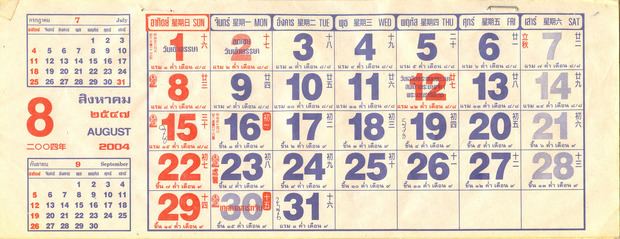 | ||
The Thai solar calendar, (Thai: ปฏิทินสุริยคติ, rtgs: patithin suriyakhati, "solar calendar"), was adopted by King Chulalongkorn (Rama V) in AD 1888 as the Siamese version of the Gregorian calendar, replacing the Thai lunar calendar as the legal calendar in Thailand (though the latter is still also used, especially for traditional and religious events). Years are now counted in the Buddhist Era (B.E.): พุทธศักราช, พ.ศ., rtgs: Phutthasakkarat) which is 543 years ahead of the Christian/Common Era.
Contents
Years
The Siamese generally used two calendars, a sacred and a popular (vulgar in the classical sense). The vulgar or minor era (จุลศักราช, chula sakarat) was thought to have been instituted when the worship of Gautama was first introduced, and corresponds to the traditional Burmese calendar (abbreviated ME or BE, the latter not to be confused with the abbreviation for the Buddhist Era, which is the sacred era.)
Rattanakosin Era
King Chulalongkorn decreed a change in vulgar reckoning to the Rattanakosin Era (abbreviated RE) (รัตนโกสินทรศก, Rattanakosin Sok abbreviated ร.ศ. and R.S.) The epoch (reference date) for Year 1 was 6 April 1782 with the accession of Rama I, the foundation of the Chakri Dynasty, and the founding of Bangkok (Rattanakosin) as capital in 106 RE, AD 1888.
Buddhist Era
In Thailand the sacred, or Buddhist Era, is reckoned to have an epochal year 0 from 11 March 543 BC, believed to be the date of the death of Gautama Buddha. King Vajiravudh (Rama VI) changed year counting to this Buddhist Era (abbreviated BE) and moved the start of the year back to 1 April in 2455 BE, AD 1912. As there is no longer any reference to a vulgar or popular era, the Common Era may be presumed to have taken the place of the former.
New year
New Year, the time at which a new calendar year begins and the calendar's year count is incremented, originally coincided with the date calculated for Songkran, when the Sun transits the constellation of Aries, the first astrological sign in the Zodiac as reckoned by sidereal astrology: thus the year commenced on 11 April 1822. As previously noted, Rama VI moved the start of the year back to 1 April in 2455 BE, AD 1912.
On 6 September 1940, Prime Minister Phibunsongkhram decreed 1 January 1941 as the start of the year 2484 BE, so year 2483 BE had only nine months. To convert dates from 1 January to 31 March prior to that year, the number to add or subtract is 542; otherwise, it is 543. Example:
Today, both the Common Era New Year's Day (1 January) and the traditional Thai New Year (สงกรานต์, Songkran) celebrations (13–15 April) are public holidays in Thailand. In the traditional Thai calendar, the change to the next Chinese zodiacal animal occurs at Songkran (now fixed at 13 April.) For Thai Chinese communities in Thailand, however, the Chinese calendar determines the day that a Chinese New Year begins, and assumes the name of the next animal in the twelve-year animal cycle.
Months
Names of the months derive from Hindu astrology names for the signs of the zodiac. Thirty-day-month names end in -ayon (-ายน), from Sanskrit root āyana : the arrival of; 31-day-month names end in -akhom (-าคม), from Sanskrit āgama (cognate to English "come") that also means the arrival of.
February's name ends in -phan (-พันธ์), from Sanskrit bandha : "fettered" or "bound". The day added to February in a solar leap year is Athikasuratin (อธิกสุรทิน, respelled to aid pronunciation (อะทิกะสุระทิน) from Sanskrit adhika : additional; sura : move).
